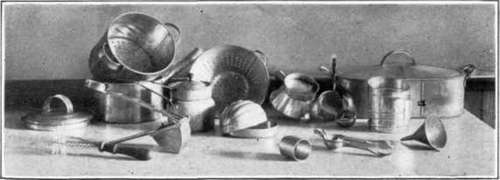Directions For Measuring
Description
This section is from the book "Elements Of The Theory And Practice Of Cookery", by Mary E. Williams. Also available from Amazon: Elements Of The Theory And Practice Of Cookery; A Textbook Of Domestic Science For Use In Schools.
Directions For Measuring
1. Sift, or shake up lightly with a spoon, all dry materials (flour, baking-powder, etc.) before measuring them. Always sift mustard.
2. All measures are to be taken level unless otherwise directed.1
3. To measure a cupful of dry material, fill the cup with a spoon or scoop, and level off with a case-knife. To measure a teaspoonful or tablespoonful of dry material, fill the spoon by dipping it into the material, lift it, and level off with a case-knife. To measure a half-spoonful, divide a spoon lengthwise with the knife. Divide a half-spoonful crosswise to measure a quarter, and a quarter-spoonful crosswise to measure an eighth. Less than an eighth of a teaspoonful is called "a few grains."
1 In some cookbooks, including all published before 1896, it is intended that spoonfuls of flour, baking-powder, sugar, butter, and lard should be measured rounded. One rounded spoonful is equal to two level spoonfuls.
Plate IV.

Steamer Colander Strainers
Double boiler Melon-mold
Vegetable press (for puddings, ice cream, etc.) Potato-masher Biscuit-cutter
Fish-boiler Flour-sifter Funnel Lemon-squeezer
Cooking Utensils.
4. A cupful of liquid is all the cup will hold; a spoonful of liquid is all the spoon will hold. A heaping spoonful of dry material is all the spoon will hold. A scant cupful is measured by filling the cup to within one-eighth of an inch of the brim.
Note
Success in cooking depends greatly upon accuracy in measuring. Only after much practice in measuring as here directed, should you venture to measure even small quantities by your eye. The requirement of accurate measuring and the giving of exact quantities of material in the recipes in this book, are not intended, however, to do away with the exercise of individual taste and judgment. So long as flours vary in thickening quality, and spices and other cooking materials in strength, it will be impossible to write recipes that can be followed absolutely in all cases. Follow a recipe exactly the first time you use it; if it requires to be varied, you can then make the change intelligently; but if you have not followed it exactly, you cannot be sure which is at fault, the recipe or the cook.
The quantities of seasonings given in this book are, as a rule, the smallest desirable. Increase them cautiously to suit your taste; but do not fall into the error, common in America, of overseasoning food with pepper and salt.
Note To Teacher
In dividing recipes to make individual recipes for practice-work, allow more liquid proportionately than the whole recipe calls for. More proportionately of a small quantity of liquid will cling to cup or spoon, and more will be lost by evaporation in cooking.
One egg beaten usually makes about one-fourth of a cupful. If you are dividing by eight a recipe which calls for one egg, use two teaspoon-fuls of beaten egg in the individual recipe.
In individual recipes use baking-powder in the proportion of two tea-spoonfuls to one cupful of flour.
Individual Recipe for Standard Cake (p. 277)
Butter, 1/2 tb. Sugar, 2 tb. Beaten egg, 1 tb. Milk, 1 tb.
Flour, 3 tb. Baking-powder, 1/4 t. Vanilla, 4 drops Salt, f. g.
Table of Abbreviations used in this Book tb. stands for tablespoonful, or tablespoonfuls t. stands for teaspoonful, or teaspoonfuls.
c. stands for cupful, or cupfuls.
qt. stands for quart.
pt. stands for pint.
lb. stands for pound.
oz. stands for ounce.
f.g. stands for a few grains.
r. stands for rounded.
In some books T. or tbsp. stands for tablespoonful, and tsp. for tea-spoonful.
hp. stands for heaping.
sc. stands for scant.
min. stands for minute, or minutes.
hr. stands for hour.
Hints On How To Work
1. See that the fire is ready for use, or so arranged that it will be ready by the time it is needed.
2. Collect all the materials that will be needed.
3. Collect all the dishes, spoons, and other utensils that will be needed, including a plate on which to lay sticky spoons, knives, etc.
4. Take care not to make work for yourself by using more utensils than are necessary. For instance, by measuring dry materials first, then liquids, and last, fats, you need use only one cup.
5. When milk and eggs are used, save a little of the milk to rinse out the bowl in which the eggs are beaten.
6. Use an earthen bowl for mixing cakes, muffins, etc.
A tin dish and an iron spoon are likely to discolor the mixture.
7. Have all materials ready for use (flour sifted and measured, eggs broken, raisins stoned, etc.), before beginning to put them together.
8. Cover flour-barrel, sugar-bucket, baking-powder can, etc., as soon as you have taken from them what you need.
9. Clear up as you work, putting dishes to soak as soon as they are emptied, and washing them at once if you have a moment to spare.
10. When you have finished, collect all the dishes that remain, saving any unused material that is in good condition.
11. Learn to work neatly, carefully, quietly, and quickly.
Continue to:


